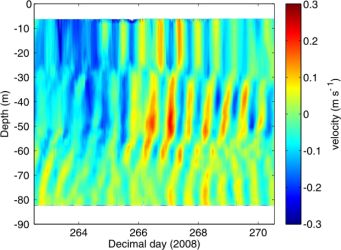
Project details: ILWAO II
| Acronym: | ILWAO II |
|---|---|
| Title: | International Leibniz Graduate School for Gravity Waves and Turbulence in the Ocean |
| Duration: | 01.07.2012 - 30.06.2017 |
| Contact: | Prof. Dr. Hans Burchard |
| Funding: | Leibniz-Gemeinschaft |
| Cooperation: | Leibniz-Institut für Atmosphärenphysik (IAP) Universität Rostock |
Description
The "International Leibniz Graduate School for Internal Waves in the Atmosphere and Ocean" (ILWAO) is a joint research initiative of several German research instiutes. The goal is to understand the role of internal waves for mixing and transport in an interdisciplinary approach, including internal waves in the atmosphere, in the ocean, in the laboratory, and in plasmas.
The observations during ILWAO-I allowed us to associate shear-bands with regions of enhanced mixing. But the vertical resolution was too low to study the breaking process in detail. We plan to base new observations in the Bornholm Basin on a nested instrumental approach using various short-term deployments: the water column of approximately 90 m depth will be sampled simultaneously with different moored ADCPs and moored CTD loggers, each covering different temporal and spatial resolution. Apart from this bottom-mounted instrumentation, we plan to locate an instrument platform directly inside the shear-bands mentioned above. Mixing parameters will be provided from (a) simultaneous microstructure ship observations, and (b) from the structure function approach to infer dissipation rates from high-resolution velocity profiles. With this, we will be able to resolve individual shear-instabilities, and relate them to the large-scale internal-wave field and local changes in mixing.
Our second study site will be the Gotland Basin, the largest of the deep basins of the central Baltic Sea, where IOW has recently established an autonomous profiling station. We plan to extend this profiler platform with instrumentation to infer internal-wave parameters and mixing rates at the vertical scale of individual shear-instabilities. Shear data at sufficiently high resolution will be provided by an acoustic current meter, and high-resolution stratification will be measured by the existing CTD system. Mixing rates will be inferred from temperature and conductivity microsensors.
The numerical modelling during ILWAO-II will follow two major tasks: The internal mixing parameterisation for shelf seas suggested some years ago in the literature (supported by results from ILWAO-I) will be refined using data from ILWAO-I&II. Since this parameterisation depends on both vertical shear and stratification, the new high-resolution shear data from ILWAO-II will give new insights into the dependence of mixing on these parameters. Existing internal mixing parameterisations in GOTM will be supplemented by this new parameterization and will be tested against observational data for various scenarios in stratified basins. Finally, the turbulence parameterisation will be implemented into the 3D model GETM to quantitatively reproduce observed inertial motions in the Bornholm Sea and other basins of the Baltic Sea. While the large hydrostatic scales will be resolved by the model, it is the aim to consistently parameterize the smaller non-hydrostatic scales and their feedback to the larger scales.
Project details: ILWAO
| Acronym: | ILWAO |
|---|---|
| Title: | International Leibniz Graduate School for Gravity Waves and Turbulence in the Atmosphere and Ocean |
| Duration: | 01.01.2007 - 31.12.2011 |
| Project manager: | Prof. Dr. Hans Burchard |
| Funding: | WGL |
| Focus: | Transport and transformation processes |
| Department: | Physical Oceanography and Instrumentation |
| Participation: | Franz-Josef Lübken (IAP, Kühlungsborn, Germany) |
Description

The "International Leibniz Graduate School for Internal Waves in the Atmosphere and Ocean" (ILWAO) is a joint research initiative of several German research instiutes. The goal is to understand the role of internal waves for mixing and transport in an interdisciplinary approach, including internal waves in the atmosphere, in the ocean, in the laboratory, and in plasmas. The oceanic part carried out by IOW includes two PhD projects working on the field and numerical research program, respectively.
The field work focuses on the contribution of near-inertial waves (see figures on the right) for boundary mixing, and on the behavior of high-frequency internal waves near the slopes. The study areas are the Bornholm Basin and the Stolpe Channel in the southern part of the Baltic Sea. The field program combines high-resolution moored instrumentation with densely-spaced microstructure and velocity transects across the sloping topography of the basin.
The major goal of the numerical project is the development of a suitable parameterisation for the mixing caused by breaking internal waves. Therefore the propagation and degeneration of internal waves should be reproduced and compared to measurements. As a preparation the existing numerical model was extended to include nonhydrostatic dynamics necessary to correctly simulate the dispersion of internal waves (see animation below).
Nonhydrostatic dispersing interfacial seiche waves